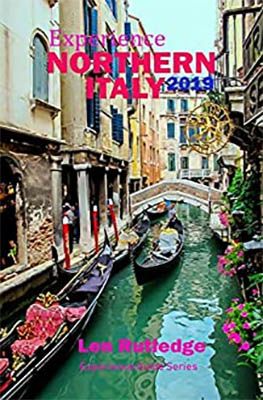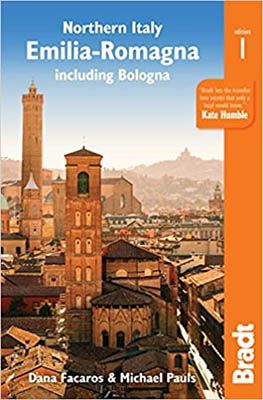Recently we visited the beautiful Adriatic coast of north-eastern Italy. We chose Ravenna as our base from which to explore the area. A perfect choice because Ravenna turned out to be not only a cultural-historical pearl in this part of Italy. The former capital of the Western Roman Empire is also a very pleasant town. Ravenna is a typical city that you should not miss during a tour of north-east Italy. In this blog we will tell you why.
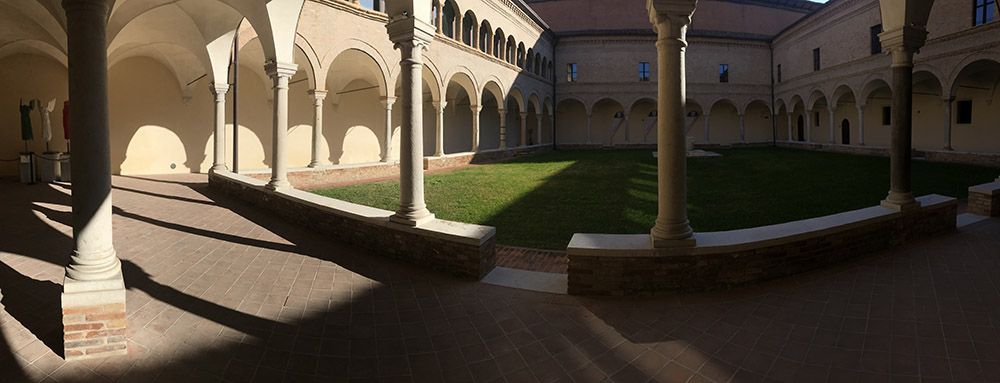
Our visit to Ravenna, the beautiful Italian capital of mosaics
Ravenna is the ancient Italian capital of mosaic, with the lovely atmosphere of a small town. Before the Christian era, it was still a remote village with houses on wooden stilts. Many generations of fishermen and farmers lived there protected by the marshes around them. That changed when the Roman Emperor Octavius Augustus Caesar turned the area into a naval base. It eventually became Rome’s largest naval base in the Adriatic.
Four centuries later, Rome fell into decline. The great European city of Ravenna then became the capital of the Western Roman Empire. Not much later, the city fell under the regime of the Byzantines. In the flourishing period that followed, large churches were built with beautiful mosaics. Many of them, like the Basilica of San Vitale, can still be admired in all their splendour.
In the 8th century, Ravenna was almost completely looted by Pipin and Charlemagne. The city then withdrew into its marshes in complete isolation. This made the city a perfect refuge for Dante Alighieri, the great 14th century poet. Ravenna did not overcome the period under the yoke of the powerful Popes. In later centuries, the city was no more than a pretty provincial town: isolated and economically backward. But maybe that is precisely why it is a fantastic destination for a city trip! What remains is a pleasant, wonderfully compact town full of culinary and cultural surprises. And a pleasant location from which the other historical highlights of the region can be easily visited.
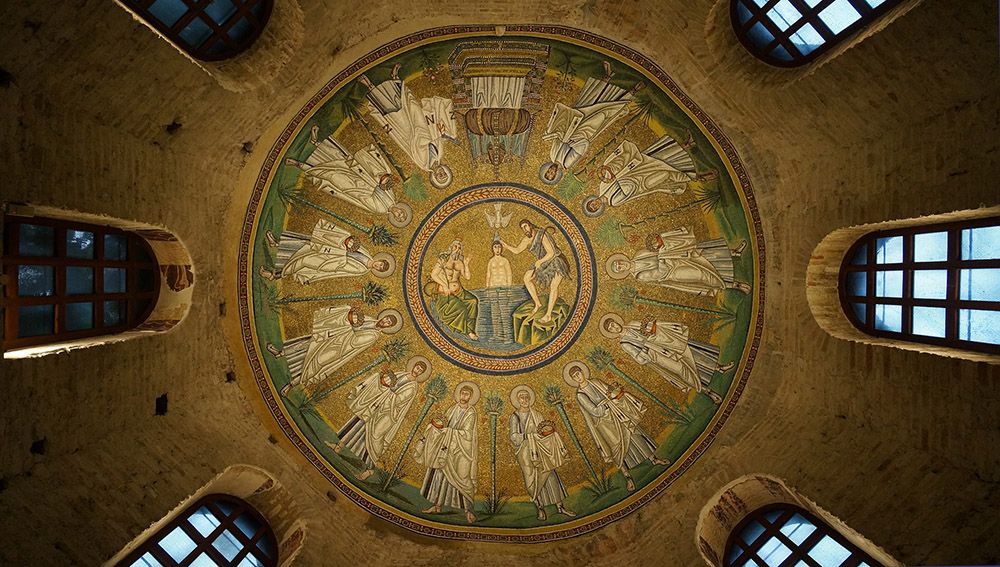
Most beautiful sights of Ravenna that you must see
Take your time to walk around in this capital of mosaics. You will find information boards at the most important sights. During our many short walks in the city, we decided on the spot whether we wanted to go inside or not. If you don’t have that much time, an official walk is a better option. You can do it by yourself or with a guide. Do you want to visit several locations with the most beautiful mosaics? Then buy a combination ticket. This will save you money and time in queuing at the ticket office.
Whichever city tour you take, make sure you at least take in the following sights:
Basilica di San Vitale
The Basilica of San Vitale has been a UNESCO World Heritage Site for 25 years. The octagonal basilica was built in the mid-6th century. The uniquely beautiful San Vitale is world-famous mainly for its mosaics. The basilica is considered one of the most important religious buildings of Byzantine architecture.
We can only confirm this. As soon as we walk in, we are overwhelmed with ‘ohhs’ and ‘ahhs’. It is incredible that the mosaics are almost 1600 years old. And they still look as they used to. Bar some necessary restorations. They are the largest and best preserved mosaics outside Constantinople. The Eucharistic sacrifice from the Old Testament is the central theme of the mosaics but there are also mosaics of the rulers of that time and of a beardless Christ. The level of detail is really incredible and the colours (especially gold and green) are exceptionally beautiful.
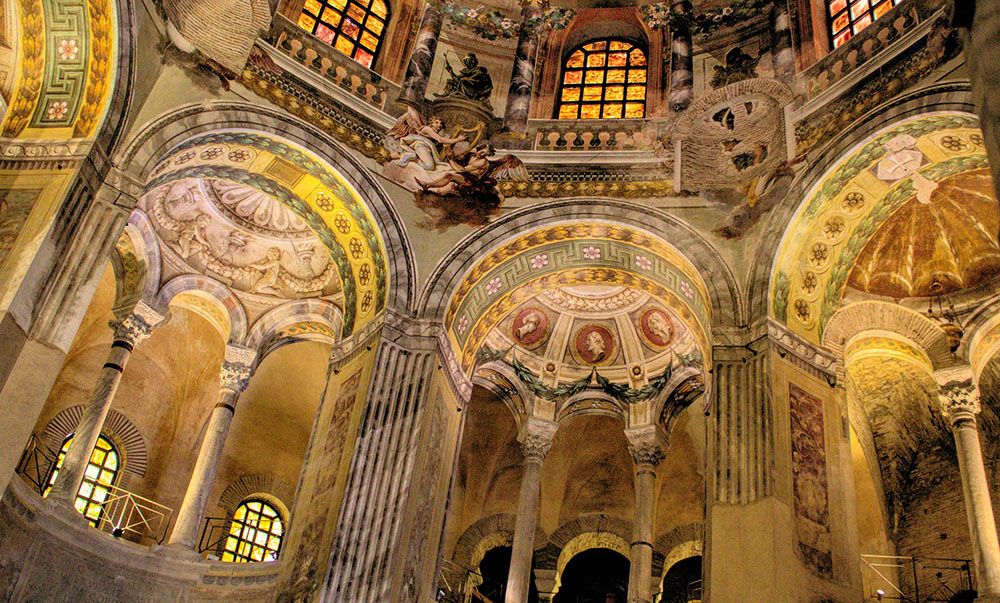
Mausoleum of Galla Placida
In the immediate vicinity of San Vitale there are more beautiful historical highlights to admire. Like the beautiful Chiesa di Santa Maria Maggiore, a church in Roman style. Very close to it, there is also the Mausoleum of Galla Placida. The Basilica of San Vitale is considered one of the most beautiful religious buildings in north-east Italy. However, we were equally impressed by the Mausoleum of Galla Placida.
The mausoleum was commissioned by Galla Placidia, daughter of the Roman emperor, in the early 5th century. The red-brick building looks sober from the outside. But once inside, you find yourself in a completely different world. The central theme of the incredibly beautiful mosaics is the shepherd offering salvation to the deceased. All the other mosaics are grouped around this theme. Yet the mosaics make the individual elements of the mausoleum look completely different. Think, for example, of nocturnal shades in the dome and lighter vaults. This play of light and colour makes the interior seem larger than it really is. Very special!
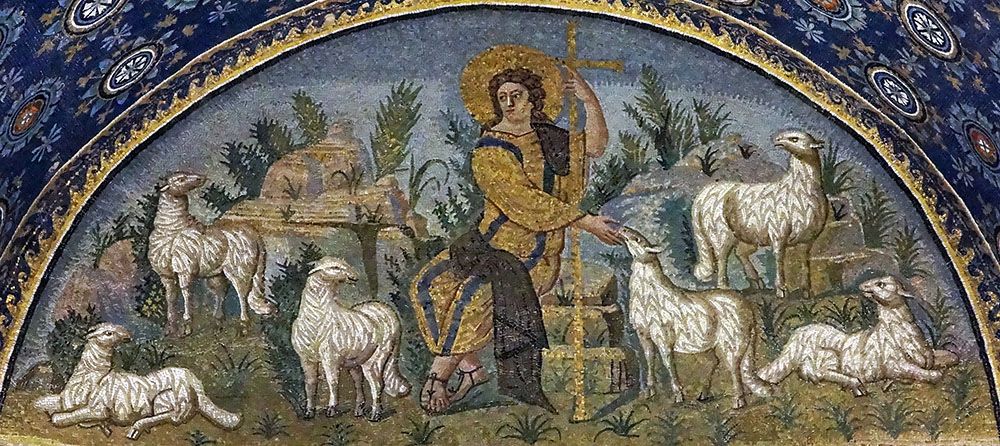
Rock carpets
We found a nice surprise in Domus dei Tappeti di Pietra, the house of stone carpets. It is one of the largest archaeological sites in Italy in recent decades. The stone carpets are about three metres under the ground. Here you will find 14 rooms in an area of about 400 square metres. The floors are paved with Roman mosaics and marble. They are perhaps not as beautiful as the Byzantine mosaics in the old religious buildings of Ravenna. But they are special and definitely worth a visit!
The walking route next to and over the non-religious mosaics is beautifully laid out. The room itself has a pleasant feel, thanks also to the excellent lighting. Not like the dank, cold cellar of an old Roman house. The entrance is in the Sant’Eufemia Church on Via Gian Battista Barbiani.
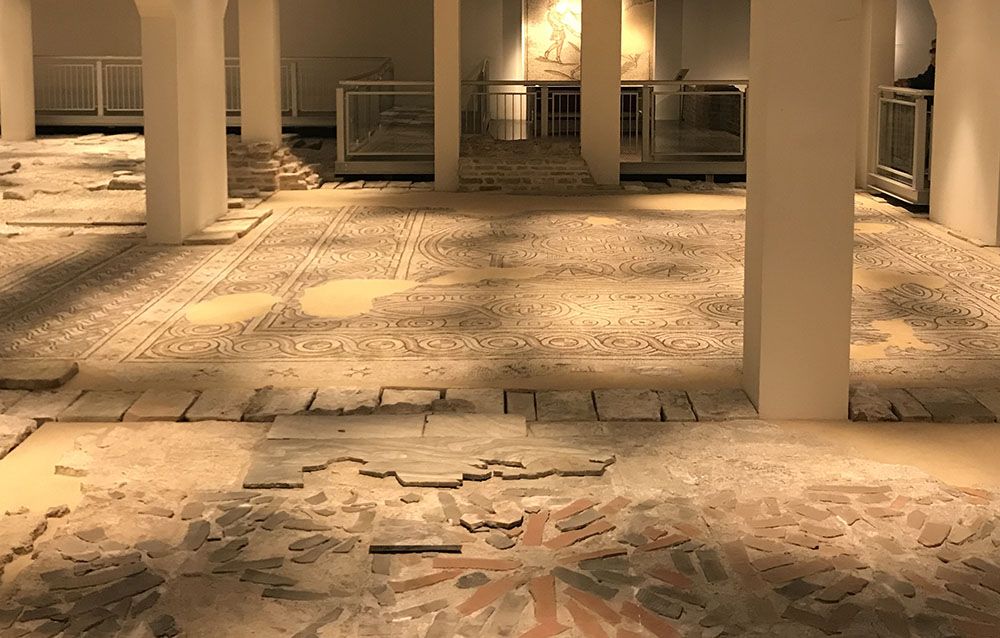
Basilica of Sant’Apollinare in Classe
Just outside Ravenna is the Basilica of Sant’Apollinare. It is a basilica that we consider to be equal to San Vitale. Because of its location, it is usually skipped by tourists. Completely undeserved, because the mosaics are absolutely beautiful! The Basilica of Sant’Apollinare dates, just like San Vitale, from the beginning of the 6th century. The most striking feature of the religious building is the gate of honour with the original mosaic. But also the mosaics in the apse (niche-shaped space at the back) are extremely beautiful. The nice thing about this basilica is that it is so quiet. If you do not like mosaics, but you want to see them, go here.
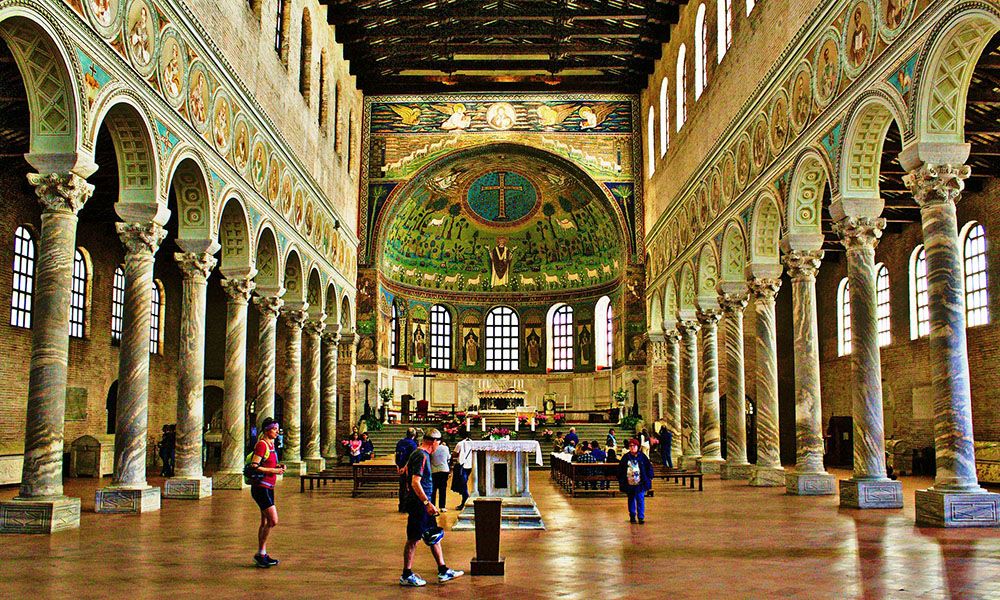
Other sights near Ravenna
Ravenna was much more than just mosaics for us. The archbishop’s palace, with the archbishop’s chapel inside, is definitely worth a visit. The private residence of the bishops from the beginning of the 6th century contains a lot of marble and ancient mosaics. Also interesting is the small museum with an Egyptian throne full of ivory reliefs.
Another interesting sight is the tomb of Dante, the famous poet from Florence. Dante Alighieri spent the last 19 years of his life in exile in Ravenna. His 18th-century tomb is to the left of the Basilica di San Francesco. Inside there is a Roman sarcophagus and a relief of a pensive Dante.
But besides religious buildings, Ravenna, like most old Italian cities, has beautiful piazzas. One of them is the Piazza del Popolo. This square from the 15th century is located in the heart of the historical centre. It is a beautiful square with many cosy terraces and excellent coffee shops. Along the square, there are several beautiful historical buildings. However, do not forget to visit the neighbouring squares through the narrow alleys. For example, Piazza Luigi Einaudi and Piazza Unità d’Italia.
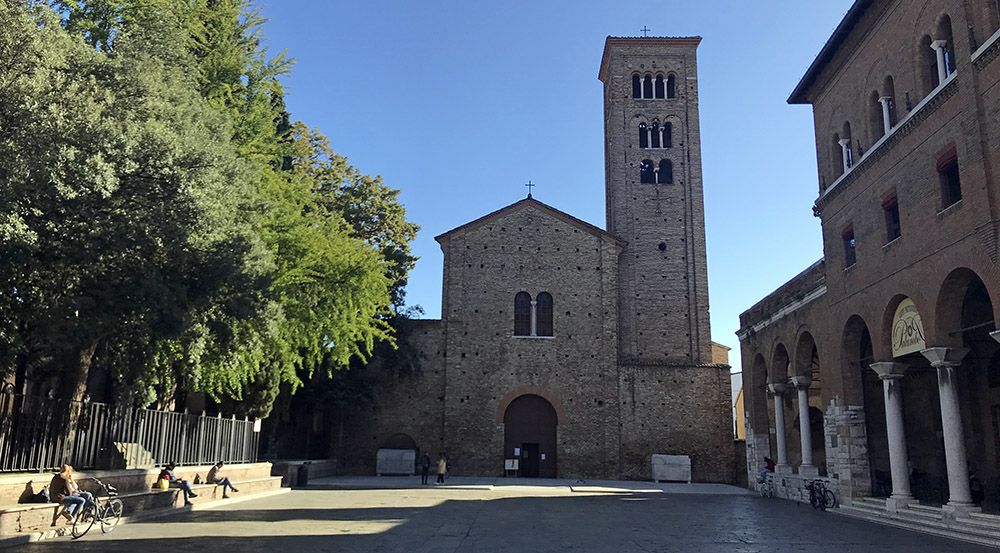
Visit to Ravenna: Practicalities
Ravenna is easily reached from the A14 motorway. Then the roads leading to the city are clearly signposted. Follow the signs for Centro. In the centre itself, the main roads are fine. However, the small, narrow streets can be a challenge for your car. Therefore, try to find accommodation that either has its own parking facilities or is close to a car park. The larger car parks are often free.
Once in Ravenna, all the sights and restaurants are easily accessible on foot. The old town is for the most part a pedestrian area. We ourselves only took the car when we went to the Ravenna Marina. Or even further, like to Rimini.
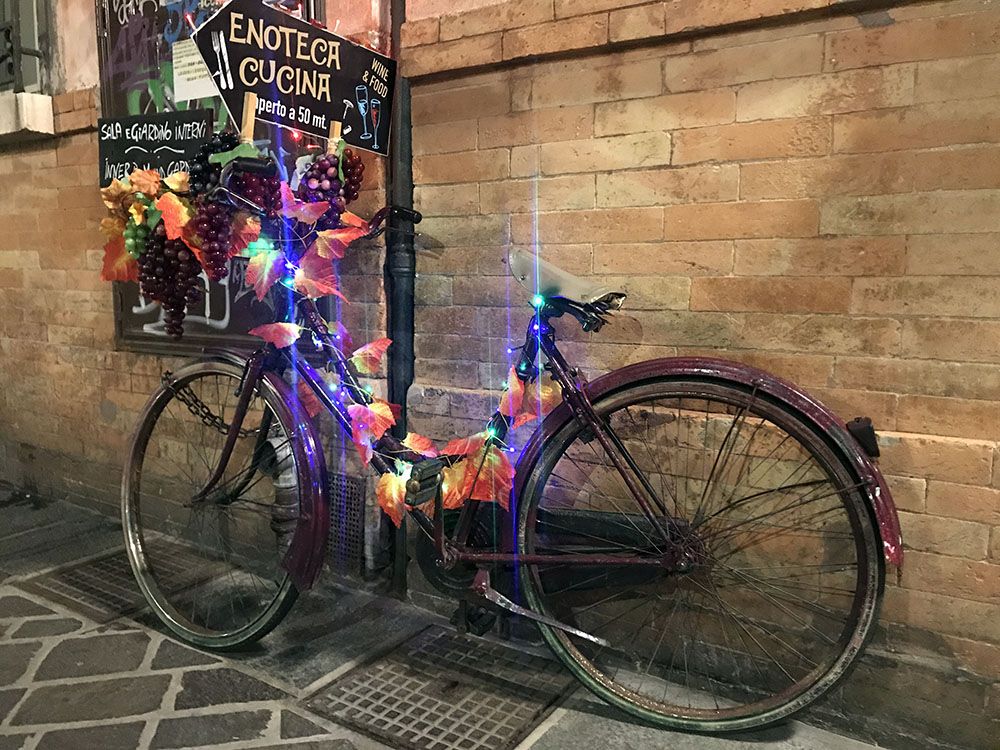
The best time to visit Ravenna is from May to mid-October. During these months there is least precipitation. A disadvantage of the real summer months is that it can be quite crowded and hot! We were there in October and had mostly blue skies. Pleasantly warm during the day, quite chilly on the terrace in the evening. Fortunately, many restaurants have terrace heating.
There is plenty of accommodation in Ravenna. We first stayed at Sant'Agata on the edge of the old town. Because we had to park our car in an unguarded (free) car park, we moved anyway. After two nights we moved on to the comfortable Appartamento Placidus in the middle of the centre. Here we could park our car on a closed courtyard. Only disadvantage of this flat is that you hear the engine of the gate to the courtyard. Click here for a list of all accommodations in Ravenna.
Of all the European cuisines, the Italian one is one of our absolute favourites. Of course you can’t call it Italian cuisine as every region is different. Even within a certain region, dishes can taste completely different because of the use of different cheeses, for example.
Ravenna, like Venice, is located in the Emilia-Romagna region. The regional cuisine of this area is known for its fattier pasta meals. Think of lasagna, tortellini, mortadella, pancetta, etc. But also the Prosciutto di Parma, Parmigiano Reggiano and the Piadina. Especially the latter, a kind of flat somewhat salty pancake, could count on our enthusiasm. The piadina tastes delicious on its own but even better with a filling such as prosciutto or cheese.
Fortunately, the quality of the many eateries and restaurants in Ravenna did not disappoint us. You can find excellent piadina in Ravenna. For example at Profumo di Piadina on the Via Cairoli. An incredibly good lunch! Other good tips for piadina are Dante Piadina di Rinalda and Il Lokalino. For a delicious dinner, we think you should go to Cabiria. Or to Osteria il Paiola (also for fish) or Azienda Agricola Palazzo Manzoni. But you should also try one of the many, super cosy terraces in the old centre. Perhaps less culinary highlights as the previously mentioned restaurants. But still good food, and above all, an often excellent ambiance.

